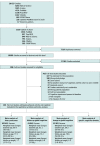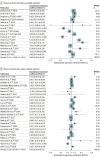Physical Activity and Cognitive Decline Among Older Adults: A Systematic Review and Meta-Analysis
- PMID: 38300618
- PMCID: PMC10835510
- DOI: 10.1001/jamanetworkopen.2023.54285
Physical Activity and Cognitive Decline Among Older Adults: A Systematic Review and Meta-Analysis
Abstract
Importance: Physical activity is associated with the risk for cognitive decline, but much of the evidence in this domain comes from studies with short follow-ups, which is prone to reverse causation bias.
Objective: To examine how length of follow-up, baseline age, physical activity amount, and study quality modify the longitudinal associations of physical activity with cognition.
Data sources: Observational studies of adults with a prospective follow-up of at least 1 year, a valid baseline cognitive measure or midlife cohort, and an estimate of the association of baseline physical activity and follow-up cognition were sought from PsycInfo, Scopus, CINAHL, Web of Science, SPORTDiscus, and PubMed, with the final search conducted on November 2, 2022.
Study selection: Two independent researchers screened titles with abstracts and full-text reports.
Data extraction and synthesis: Two reviewers independently assessed study quality and extracted data. Pooled estimates of association were calculated with random-effects meta-analyses. An extensive set of moderators, funnel plots, and scatter plots of physical activity amount were examined. This study is reported following the Preferred Reporting Items for Systematic Reviews and Meta-analyses (PRISMA) reporting guideline.
Main outcomes and measures: Pooled estimates of the associations between physical activity and global cognition, as well as specific cognitive domains, were examined.
Results: A total of 104 studies with 341 471 participants were assessed. Analysis of binary outcomes included 45 studies with 102 452 individuals, analysis of follow-up global cognition included 14 studies with 41 045 individuals, and analysis of change in global cognition included 25 studies with 67 463 individuals. Physical activity was associated with a decreased incidence of cognitive impairment or decline after correction for funnel plot asymmetry (pooled risk ratio, 0.97; 95% CI, 0.97-0.99), but there was no significant association in follow-ups longer than 10 years. Physical activity was associated with follow-up global cognition (standardized regression coefficient, 0.03; 95% CI, 0.02-0.03) and change in global cognition (standardized regression coefficient, 0.01; 95% CI, 0.01 to 0.02) from trim-and-fill analyses, with no clear dose-response or moderation by follow-up length, baseline age, study quality or adjustment for baseline cognition. The specific cognitive domains associated with physical activity were episodic memory (standardized regression coefficient, 0.03; 95% CI, 0.02-0.04) and verbal fluency (standardized regression coefficient, 0.05; 95% CI, 0.03-0.08).
Conclusions and relevance: In this meta-analysis of the association of physical activity with cognitive decline, physical activity was associated with better late-life cognition, but the association was weak. However, even a weak association is important from a population health perspective.
Conflict of interest statement
Figures



References
-
- Erickson KI, Hillman C, Stillman CM, et al. ; for 2018 Physical Activity Guidelines Advisory Committee . Physical activity, cognition, and brain outcomes: a review of the 2018 physical activity guidelines. Med Sci Sports Exerc. 2019;51(6):1242-1251. doi:10.1249/MSS.0000000000001936 - DOI - PMC - PubMed
-
- Iso-Markku P, Kujala UM, Knittle K, Polet J, Vuoksimaa E, Waller K. Physical activity as a protective factor for dementia and Alzheimer’s disease: systematic review, meta-analysis and quality assessment of cohort and case-control studies. Br J Sports Med. 2022;56(12):701-709. doi:10.1136/bjsports-2021-104981 - DOI - PMC - PubMed
Publication types
MeSH terms
LinkOut - more resources
Full Text Sources
Medical

